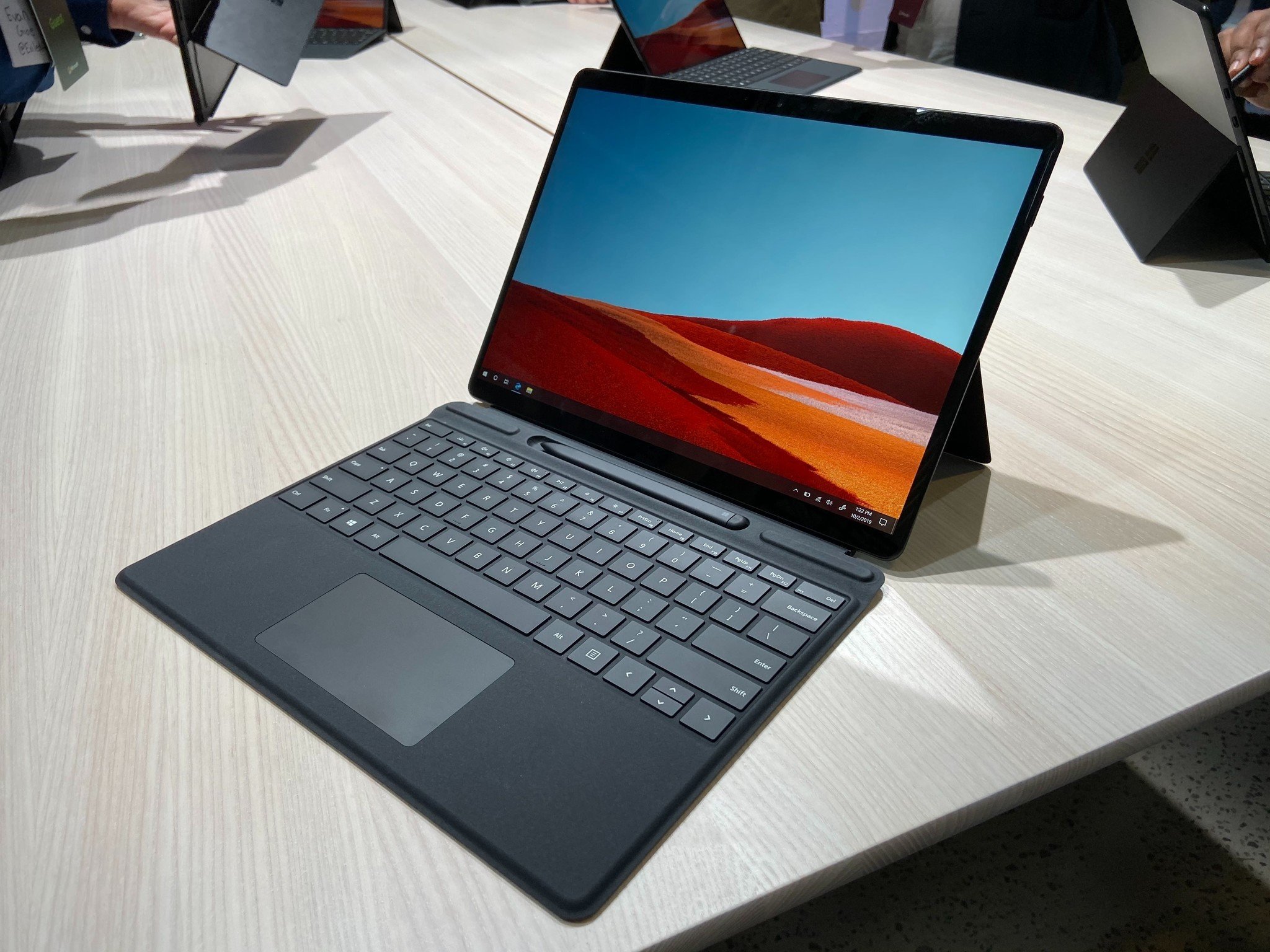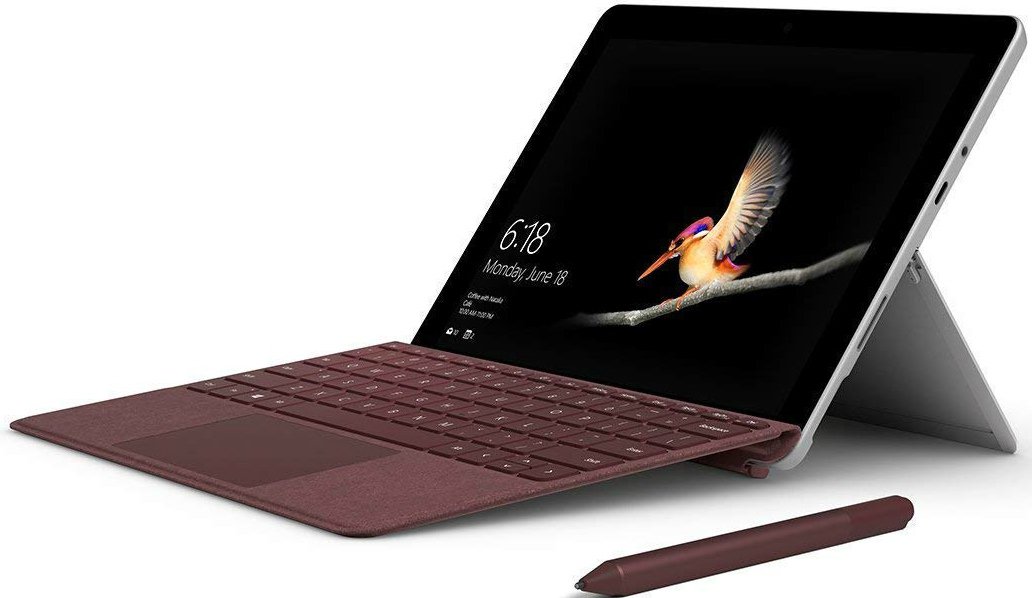

ARM-powered Pro
The Surface Pro X is Microsoft's thinnest Pro to date, but it lacks a 3.5mm audio jack and microSD card reader. LTE connectivity comes standard on all models, you get two USB-C 3.1 ports, and the high-res touch display is a knockout, especially combined with the new Surface Slim Pen. The Pro X will outpace the Go thanks to a custom SQ1 ARM processor (CPU) and Adreno 685 GPU, but you'll ultimately pay quite a bit more.
Pros
- LTE connectivity with all models
- Two USB-C ports
- Smart design with new Surface Slim Pen
- Adreno 685 GPU with two teraflops
- High-res touch display
Cons
- Considerably more expensive
- No 3.5mm audio or microSD card reader
- ARM has some limitations

Ultraportable Surface
You can save quite a bit of money by going with the Surface Go, but it's best cut out for casual computing due to the hardware options inside. LTE is optional, it has a more varied port selection, and it still has a beautiful touch display compatible with the Surface Pen. Battery life won't match up to the Pro X, but the Go is an excellent choice if you want to remain as mobile as possible.
Pros
- More portable design
- Much more affordable
- Optional LTE available
- Varied port selection
- High-res touch display
Cons
- Not as powerful as the Pro X
- Battery life not as impressive
These two Surface devices are built with mobility in mind, and they're both built to a high standard. The Go is more of a casual device that you can tuck under your arm and take to the cafe, while the Pro X is more of a professional's tool with better performance and a larger display. Let's take a look at the specs that make up these two devices.
Surface Pro X vs. Surface Go tech specs
| Header Cell - Column 0 | Surface Pro X | Surface Go |
|---|---|---|
| OS | Windows 10 | Windows 10 in S mode |
| Processor | Microsoft SQ1 | Intel Pentium Gold 4415Y |
| RAM | 8GB, 16GB LPDDR4x | 4GB, 8GB LPDDR3 |
| Storage | 128GB, 256GB, 512GB SSD | 64GB eMMC 128GB SSD |
| Display size | 13 inches Touch | 10 inches Touch |
| Display resolution | 2880x1920 267 PPI | 1800x1200 217 PPI |
| Aspect ratio | 3:2 | 3:2 |
| Graphics | Adreno 685 | Intel HD Graphics 615 |
| Ports | Two USB-C 3.1 (Gen 2) Surface Connect Nano SIM | USB-C 3.1 (Gen 1) microSD card reader 3.5mm audio Surface Connect |
| LTE | Standard Qualcomm Snapdragon X24 | Optional Qualcomm X16 |
| Camera | Front-facing 5MP (1080p) Rear-facing 10MP (4K) | Front-facing 5MP (1080p) Rear-facing 8MP (1080p) |
| Biometrics | IR camera | IR camera |
| Battery | Up to 13 hours | Up to 9 hours 26Wh |
| Dimensions | 11.3 x 8.2 x 0.28 inches (287mm x 208mm x 7.3mm) | 9.65 x 6.90 x 0.33 inches (245mm x 175mm x 8.3mm) |
| Weight | From 1.7 pounds (774g) | From 1.15 pounds (522g) |
| Color | Matte Black | Silver |
Features and design
The Surface Pro X is a bit of a departure from the Pro design we've come to expect. It still has roughly the same footprint as the Surface Pro 7, but the display has been stretched out to 13 inches thanks to slimmer bezel along the sides. It's also quite a bit thinner than the Pro 7, and it even manages to come it a hair thinner than the ultraportable Surface Go.
The Surface Go still reigns when it comes to weight, starting at just 1.15 pounds (522g), but the Pro X isn't far behind at 1.7 pounds (774g). Both devices should prove to be welcome travel companions, but if you want the most mobility, opt for the Go. It also provides a more rounded selection of ports, including one USB-C 3.1, a microSD card reader, Surface Connect, and a 3.5mm audio jack. On the other hand, the Pro X comes with two USB-C 3.1, Surface Connect, and a Nano SIM slot. Note also that the Pro X is capable of handling two external 4K displays at 60Hz through USB-C (Gen 2), while the Go is only capable of a single external 4K display with USB-C (Gen 1).
While the front-facing camera on both devices is essentially the same at 5MP (1080p), the rear-facing camera on the Pro X bumps things up to 10MP (4K). The Go's rear-facing camera is stuck at 8MP (1080p), so if you're concerned about image and video quality, the Pro X is no doubt the better choice. Both devices offer LTE connectivity to keep you connected even when there's no Wi-Fi, but only the Pro X offers eSIM and physical Nano SIM options.
Both the Pro X and Go employ a folding kickstand on the back to keep the tablet propped up, and combined with an attachable keyboard and touchpad, you can turn either into a productivity machine. However, keyboards for both models are sold separately, and you'll also have to shell out extra for an active pen. The Surface Go's Type Cover offers a comfortable (if slightly cramped) backlit keyboard and Precision touchpad, and the Surface Pen connects magnetically to the side of the tablet when not in use.
The Pro X's keyboard is larger to match the overall size of the tablet, and it has a backlit keyboard and Precision touchpad. Built into the hinge portion is a storage bay for the new Surface Slim Pen, which keeps the pen charged and better protected when you're on the move.
Display and inking
The Surface Go has a smaller 10-inch touch display with a 3:2 aspect ratio and 1800x1200 resolution. Pixels-per-inch (PPI) measures out to 217, which is really not bad at all. The picture is quite beautiful, and the Surface Pen can be used with it for a quality inking experience. If you're interested in multi-tasking, though, the Pro X's larger 13-inch display is probably better suited.
All the latest news, reviews, and guides for Windows and Xbox diehards.
It also has a 3:2 aspect ratio for a boxy look, and it has a 2880x1920 resolution for a 267 PPI. The picture is going to be sharper, and it reaches up to about 450 nits for easier outdoor work. The Surface Slim Pen is likewise going to offer a natural feel. Overall, artists or design pros are likely going to want to opt for the Pro X thanks to the larger display and better performance from the Adreno 685 graphics.
Performance and price
All models of the Surface Go cost less than even the introductory Pro X model, but for a good reason. While the Go is using an Intel Pentium 4415Y CPU, the Pro X is ARM-powered with a custom SQ1 CPU that's essentially a beefed-up Snapdragon 8cx. The Pentium chip has two cores and a base clock of 1.60GHz, while the SQ1 boasts a 3GHz clock and eight cores. You're going to get far better CPU performance from the Pro X, and it also boasts an Adreno 685 GPU with two teraflops of power. Again, this easily trounces the Go, so if you want the best performance possible, you have to stick with the Pro X.
However, ARM-based PCs do have some limitations. OpenGL games won't work on ARM, and the device is overall better suited for web and scripted apps. Despite ARM chips having to emulate x86 apps, they should still run better on the Pro X. In terms of fun, we'll have to do our own testing to see precisely how well the Pro X runs, and don't expect it to be your next gaming machine. Keep in mind that Project xCloud, Microsoft's upcoming game-streaming service, can turn almost any device with a steady internet connection into a quality gaming platform.
Storage is another point of contention, with the Go offering either 64GB of slow eMMC storage or a speedier 128GB SSD. The Pro X can be had with up to 512GB of SSD storage, and the hardware is removable if you want to upgrade in the future. Finally, the Pro X can be configured with up to 16GB of LPDDR4x RAM, while the Go is capped at 8GB of LPDDR3.
Bottom line? Introductory Pro X models start at about $999, but they're going to offer far better performance and battery life than you get with the Surface Go. If you just want a casual 2-in-1 for light productivity work, web browsing, and a bit of light gaming, the Go starts at about $390.
The Surface Pro X is better cut out for professional performance
The ARM-powered Pro X brings a thin and light chassis, knockout 13-inch touch display with pen support, and LTE connectivity to keep you connected everywhere. It beats out the Surface Go in raw performance and battery life, making it the better pick for anyone who has more professional goals in mind. It does, however, cost significantly more than the Go.
The Surface Go is an affordable and portable 2-in-1
This miniaturized Surface Pro doesn't match up to the performance in the Pro X, but it's much more portable and will still offer an excellent 2-in-1 experience. Optional LTE connectivity can keep you connected anywhere, and the 10-inch touch display is brilliant, especially combined with a Surface Pen. It's also a much cheaper option compared to the Pro X.

Cale Hunt brings to Windows Central more than nine years of experience writing about laptops, PCs, accessories, games, and beyond. If it runs Windows or in some way complements the hardware, there’s a good chance he knows about it, has written about it, or is already busy testing it.



